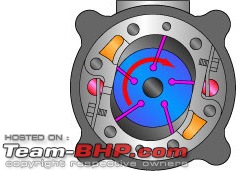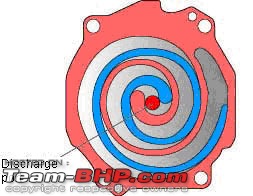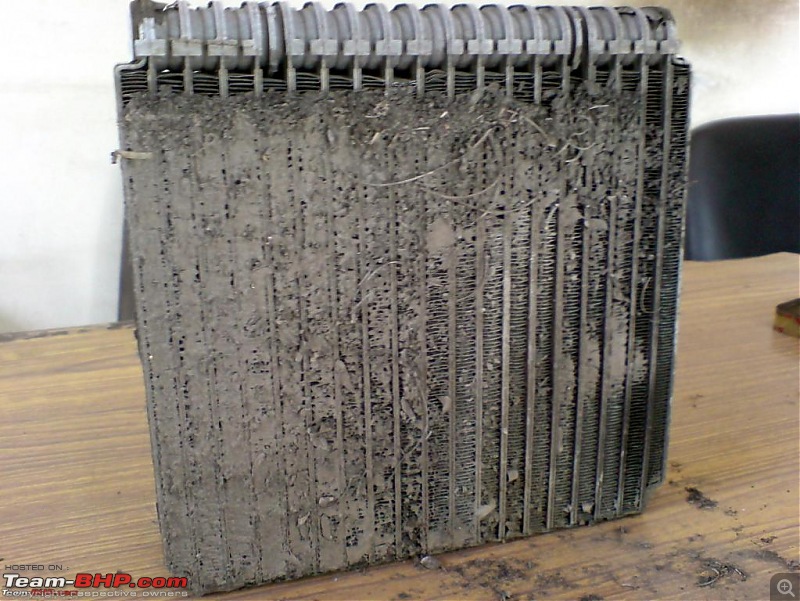| |||||||
| Search Forums |
| Advanced Search |
| Go to Page... |
 |
| Search this Thread |  244,808 views |
| | #1 |
| Senior - BHPian Join Date: Aug 2005 Location: New Delhi
Posts: 1,467
Thanked: 2,588 Times
| Understanding Car Air-Conditioners The summer heat is on. It is 42șC outside. You and family are all dressed in your Sunday best, driving the family to that all important occasion. In the middle the A/C simply gives up and dies. Welcome to the Indian summer. No, this article is not about teaching you to fix the A/C yourself - you probably won't have the equipment. No this article is not about doing some jugaad to somehow tide you over until you get to the A/C mechanic. Just roll down the windows instead as a little bit of fresh air (however hot) , won't hurt any one.  Rather, this article tells you what the A/C is made up of, and some things that can go wrong with it. Interested? Well, let's start with the basics... Refrigeration 101. The Basic Refrigeration Cycle Picture courtesy  The principle of refrigeration is based on a physical property of matter:
The refrigerant gas at a low pressure enters the compressor and is pressurized to a higher pressure.The pressurized gas then flows to the condenser where it condenses to a liquid, and gives off its heat to the outside air.The pressurized liquid then moves to the expansion valve. This valve restricts the flow of the liquid, and this reduces its pressure. The low-pressure liquid then moves to the evaporator, where heat from the inside air is absorbed and changes it from a liquid to a gas. As a hot low-pressure gas, the refrigerant again moves to the compressor where the entire refrigeration cycle is repeated. In vehicles too the same design is used. With one additional feature - the removal of moisture. In vehicles, there are two variants of the above basic system. Picture Courtesy   A) Orifice Tube and Accumulator System ----------------------------B) Expansion Valve and Receiver/Drier System From a physics perspective the main difference between the two systems is about which side the moisture gets out of the system. In A) the moisture is removed in the low pressure side. In B) the moisture is removed in the high pressure side. Last edited by joybhowmik : 3rd May 2014 at 10:33. |
| |  (30)
Thanks (30)
Thanks
|
| The following 30 BHPians Thank joybhowmik for this useful post: | 1self, Aditya, anky, anujmishra, Arun.K, audioholic, bj96, dr. sen, F150, gearedup, gm_arun, GTO, Guna, HappyWheels, iVento, jaspal singh, jinojohnt, JoseVijay, lapis_lazuli, mukeshgoel, parsh, saket77, Secretariat, sinhead, sri2012, the1984@doctor, thoma, Turbanator, VijayAnand1, wheelguy |
| |
| | #2 |
| Senior - BHPian Join Date: Aug 2005 Location: New Delhi
Posts: 1,467
Thanked: 2,588 Times
| Components of the AC system - Refrigerant Refrigerant: Usually described by the generic name "freon" the refrigerant gas is provided in pressurized containers and is usually a derivative of a haloalkaline refrigerant named 1,1,1,2-Tetrafluoroethane or R134A. This class of refrigerant and its variants and various trade names have less ozone depleting potential than the earlier R12 based refrigerants.  This gas is also the cynosure of stewards of the environment. From earlier experiences of this gas being responsible for degenerating Ozone molecules in the upper atmosphere, to today - there has been a sea change in people's attitudes towards, producing, consuming and disposing the product. Responsible manufacturers such as Dupont will often certify their product with the Atmospheric lifetime (in days) beyond which the product itself degenerates and ceases further harm to the planet. Example : One kind of Refrigerant used in Automobiles  Last edited by joybhowmik : 3rd May 2014 at 02:54. |
| |  (13)
Thanks (13)
Thanks
|
| The following 13 BHPians Thank joybhowmik for this useful post: | Aditya, anujmishra, dr. sen, gm_arun, GTO, HappyWheels, mukeshgoel, parsh, PGNarain, the1984@doctor, timuseravan, VijayAnand1, wheelguy |
| | #3 |
| Senior - BHPian Join Date: Aug 2005 Location: New Delhi
Posts: 1,467
Thanked: 2,588 Times
| Components of the AC system - Compressor Assembly Compressor Assembly The Compressor assembly consists primarily of the Compressor and Clutch. The A/C Compressor compresses the refrigerant gas to a higher pressure. It is the heart of the AC system. It is shown here with the attached Clutch. The clutch is an electromagnet.  Here's how things work...  The mechanical power from the engine crankshaft is transferred to the AC Compressor + Clutch through the Drive belt. Drive belts may be called by various names - e.g. V belt, Serpentine belt etc. (In addition to driving the AC Compressor Clutch it also drives other things e.g. the power steering pump, the alternator, water pump etc.) The clutch ( electromagnet) is powered by the AC Clutch Relay which sits inside the fuse box. When you press the A/C Switch inside the cabin, it causes the current to flow through the relay, and powers the field coil inside the clutch. The generated magnetic field in turn attracts the Clutch drive plate outwards so that presses against the inside of the rotating pulley and then rotates with it. The drive plate is mounted on the central shaft which in turn drives the compressor. The entire clutch drive plate is immersed in clutch oil for longevity, this is retained using a system of oil seals and covers. Here is an exploded view of the Clutch... 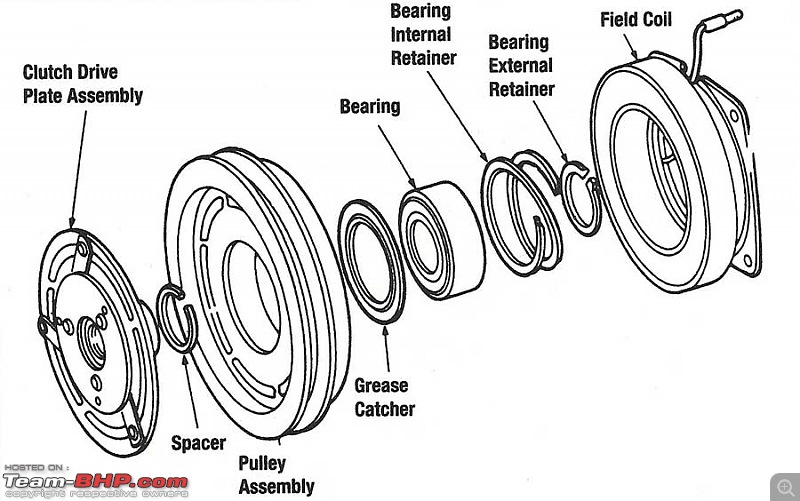 The AC Compressor is an extremely complex unit. It is not serviceable at your FNG or A.S.S. because of the extremely high tolerances of manufacturing and assembly. There are two basic types- reciprocating type and rotary type. Here are four different kindsof compressors manufactured by Toyota for their cars... 1) and 4) are reciprocating type, where as 2) and 3) are rotary type. Quote: Last edited by joybhowmik : 3rd May 2014 at 00:45. |
| |  (21)
Thanks (21)
Thanks
|
| The following 21 BHPians Thank joybhowmik for this useful post: | 1self, Aditya, anky, anujmishra, BoneCollector, dr. sen, gearedup, gm_arun, GTO, HappyWheels, jnanesh, lapis_lazuli, mukeshgoel, parsh, PGNarain, saket77, Sophomore, SS-Traveller, the1984@doctor, timuseravan, wheelguy |
| | #4 |
| Senior - BHPian Join Date: Aug 2005 Location: New Delhi
Posts: 1,467
Thanked: 2,588 Times
| Components of the AC system - Condenser A condenser is a heat exchanger (operating to the same principle as a car's radiator). It consists of a series of coils over and around which ambient air is forced to circulate by a fan. Within the coils, the hot refrigerant gas cools to a liquid, as it sheds heat. Condensers are of two types - depending on the way in which the refrigerant flows. The older Parallel types of condenser, and the newer and almost ubiquitious Serpentine type of condenser. Picture Courtesy 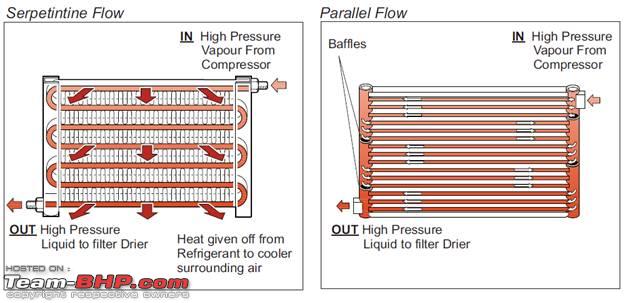 The Serpentine type of condenser is much easier to clean and can easily be flushed clean. It is the preferred design in modern cars. 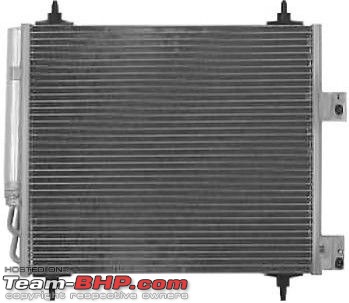 The Parallel type of condenser has multiple flow paths from inlet to outlet. This means that any debris from the compressor or any obstructing material also can get stuck in one of several pipes. Hence a pressurized flush of the condenser will never dislodge all the debris or guck. This is an example of a parallel flow condenser seen in vintage cars  Last edited by joybhowmik : 2nd May 2014 at 22:46. |
| |  (13)
Thanks (13)
Thanks
|
| The following 13 BHPians Thank joybhowmik for this useful post: | Aditya, anujmishra, dr. sen, gm_arun, GTO, HappyWheels, jnanesh, parsh, PGNarain, SS-Traveller, the1984@doctor, VijayAnand1, wheelguy |
| | #5 |
| Senior - BHPian Join Date: Aug 2005 Location: New Delhi
Posts: 1,467
Thanked: 2,588 Times
| Components of the AC system - Receiver/Drier OR Accumulator A receiver/drier is used in an Expansion Valve and Receiver/Drier type system and sits between the Condenser outlet and the Expansion valve inlet on the high pressure side. It is a tubular shaped device that contains some desiccating (drying) agent that removes moisture from the refrigerant thus preventing the formation of hydrocholric and hydrofluoric acids - both are very corrosive. In addition it filters particles mixed in the refrigerant, and acts as a refrigerant container. Below is a picture of a receiver-drier and a schematic of how it works: (Picture Courtesy)  -- --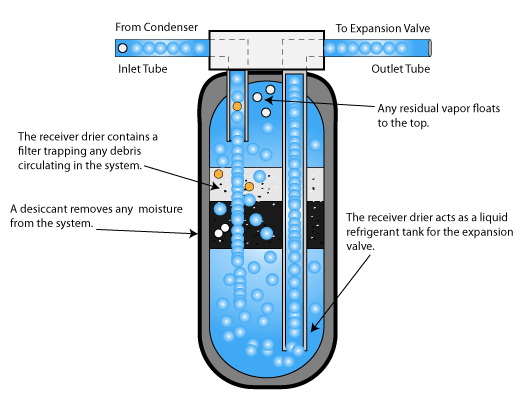 An Accumulator is used in an Orifice and Accumulator type system and sits between the Evaporator Outlet and Compressor Inlet on the Low pressure side. It is similarly shaped as the Receiver/Dryer. It has the same functions as a receiver/drier, and an additional one - the separation of liquid refrigerant from gaseous refrigerant. This is to prevent liquid lock in the compressor (it should not receive any liquid refrigerant at all, else it will fail (Black Death). Below is a picture of an Accumulator and a schematic of how it works. (Picture Courtesy)  -- -- Last edited by joybhowmik : 2nd May 2014 at 22:57. |
| |  (13)
Thanks (13)
Thanks
|
| The following 13 BHPians Thank joybhowmik for this useful post: | Aditya, anujmishra, dr. sen, gearedup, gm_arun, GTO, HappyWheels, jnanesh, lapis_lazuli, lordvader, parsh, the1984@doctor, wheelguy |
| | #6 |
| Senior - BHPian Join Date: Aug 2005 Location: New Delhi
Posts: 1,467
Thanked: 2,588 Times
| Components of the AC system - Orifice Tube OR Expansion Valve The orifice tube is used in the Orifice tube and Accumulator type system and sits between the Evaporator and Condenser. Its conical shape restricts the flow of a metred quantity of liquid refrigerant, thus reducing its pressure and it becomes a mist as it enters the Evaporator. Also, as the orifice tube is of fixed shape and capacity, it cannot be used to control the amount of refrigerant that changed to gas inside the evaporator. Therefore in this type of system, the Accumulator is used to dry the gaseous refrigerant, and store the liquid refrigerant to prevent liquid lock or Black Death in the compressor. Here is a picture of an orifice tube and it's schematic 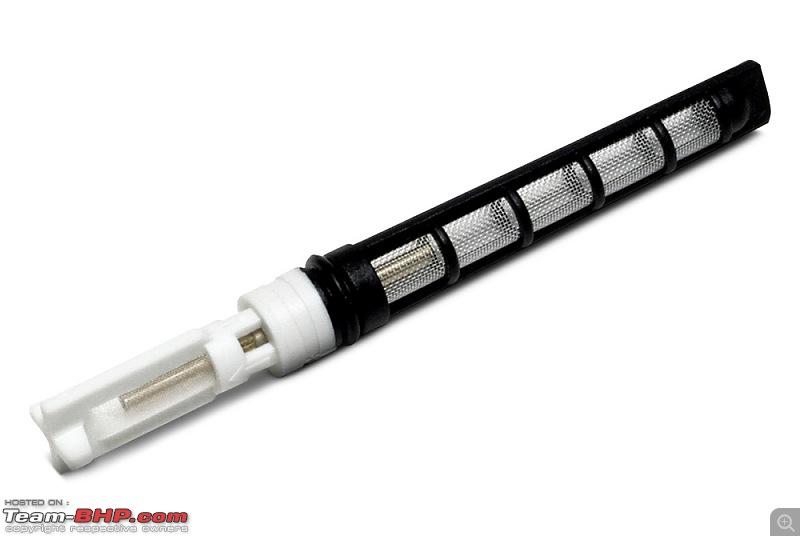 -- --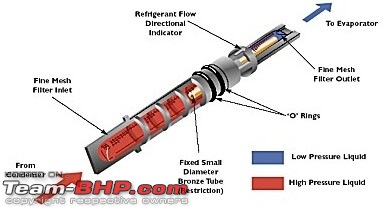 The expansion valve is used in the Expansion valve and Receiver/Drier type system and sits between the Receiver/Drier and Evaporator. It functions like the orifice tube in that the liquid refrigerant enters it at high pressure and leaves it as a low pressure mist. The device contains a temperature sensor used to measure the temperature of the refrigerant on the Evaporator outlet side. Based on the measured temperature it meters the exact quantity of refrigerant into the evaporator that will completely evaporate into gaseous state. Note there is no further drying of the refrigerant or vaporization before it enters the compressor. Picture Courtesy: Denso  Last edited by joybhowmik : 2nd May 2014 at 23:48. |
| |  (9)
Thanks (9)
Thanks
|
| The following 9 BHPians Thank joybhowmik for this useful post: | Aditya, anujmishra, dr. sen, gm_arun, GTO, HappyWheels, lordvader, parsh, the1984@doctor |
| | #7 |
| Senior - BHPian Join Date: Aug 2005 Location: New Delhi
Posts: 1,467
Thanked: 2,588 Times
| Components of the AC system - Evaporator The Evaporator is essentially a heat exchanger. It contains a core, where the low pressure, low temperature liquid refrigerant enters. Your car's blower forces the cabin air over the evaporator. Heat transfers from the cabin air, into the liquid refrigerant , boiling it into gaseous state. The cooled cabin air is circulated back into the cabin. The refrigerant either directly enters the compressor (Expansion valve and receiver/drier system) or enters the Accumulator (Orifice and Expansion valve system) where it gets dried and gaseous vapour is then sent to the compressor. Here is the picture of an evaporator and a schematic of how it works  -- --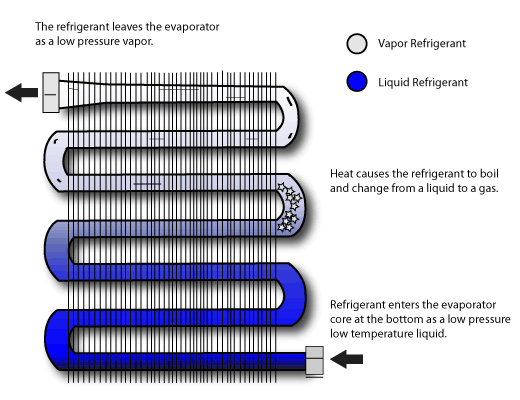 Last edited by joybhowmik : 2nd May 2014 at 23:57. |
| |  (7)
Thanks (7)
Thanks
|
| The following 7 BHPians Thank joybhowmik for this useful post: | Aditya, anujmishra, GTO, HappyWheels, lordvader, parsh, the1984@doctor |
| | #8 |
| Senior - BHPian Join Date: Aug 2005 Location: New Delhi
Posts: 1,467
Thanked: 2,588 Times
| Components of the AC system - Inline filter and cabin air filter The AC inline filter is designed to trap debris circulating with the refrigerant and take it out from further circulation. Example inline filter shown below, shapes/sizes may vary... 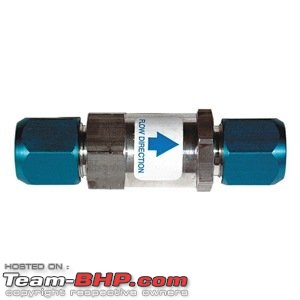 A cabin air filter is designed to trap foreign particles (and even pathogens) and prevent them from circulating within the cabin. Earlier model cars did not have this feature except in high end vehicles. Now it is almost ubiquitous. Example of a cabin air filter. 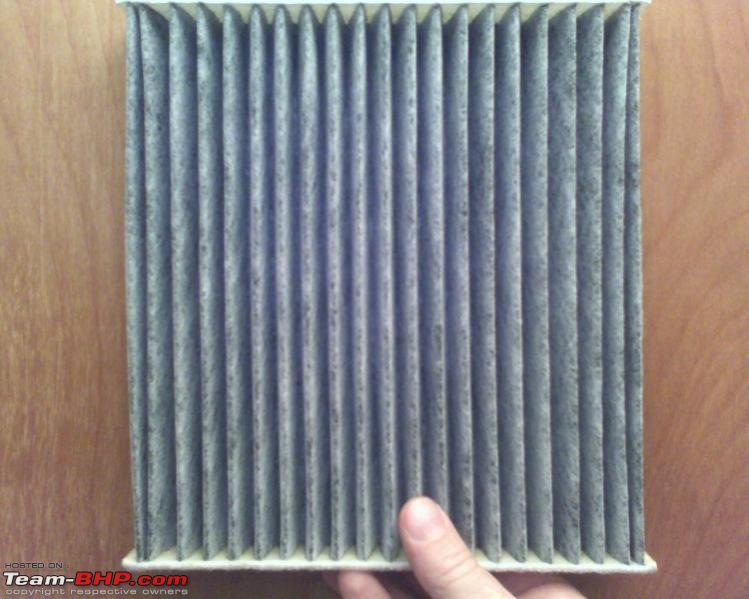 Last edited by joybhowmik : 3rd May 2014 at 02:57. |
| |  (8)
Thanks (8)
Thanks
|
| The following 8 BHPians Thank joybhowmik for this useful post: | Aditya, anujmishra, dr. sen, gm_arun, GTO, jnanesh, parsh, the1984@doctor |
| | #9 |
| Senior - BHPian Join Date: Aug 2005 Location: New Delhi
Posts: 1,467
Thanked: 2,588 Times
| Components of the AC system - Electricals Picture Courtesy: Toyota The picture shown is an electrical diagram of 1993 Toyota pickup truck, to illustrate the basic circuitry of A/C and Heater. Modern cars of course would have something more sophisticated but the principle is the same. 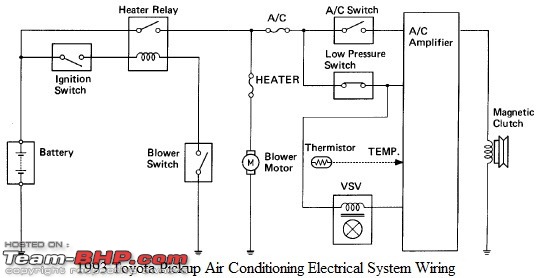 Last edited by joybhowmik : 3rd May 2014 at 01:24. |
| |  (7)
Thanks (7)
Thanks
|
| The following 7 BHPians Thank joybhowmik for this useful post: | Aditya, anujmishra, dr. sen, gm_arun, GTO, jnanesh, parsh |
| | #10 |
| Senior - BHPian Join Date: Aug 2005 Location: New Delhi
Posts: 1,467
Thanked: 2,588 Times
| What do we mean when we say the AC is working normally. Now that we know how the car AC system works, let's see what kind of pressure and temperature measurements are considered normal.  You will find that your AC service wallah - will measure the pressure using the kind of double guage ( shown below) 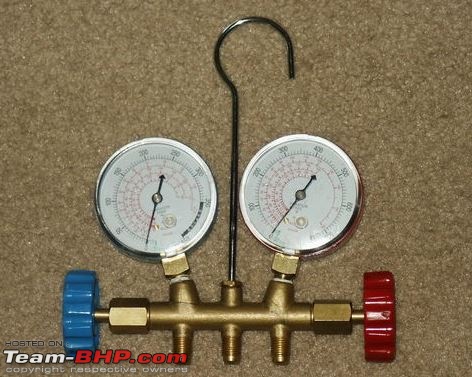 - attached to the high and low sides respectively using hoses (not shown). He also won't measure the temperature - but likely waft his hand up and down in front of the vent, while hanging his other arm nonchalantly outside the window as if it say he understands the temperature differential using his sense of touch & feel. Some skin!!!  The vent temperature can best be measured by using a simple digital probe thermometer (cooking thermometer) inserted into the vent after at least 15 minutes of driving with AC on (to stabilize) the system and shutting/blocking all the vents except that in which the temperature is to be measured.  Some professionals also use a laser guided infrared thermometer as shown below. It does not offer vastly different readings and is a little fancier.  Ambient temperature can also be measured by the digital probe thermometer shown above. Last edited by joybhowmik : 3rd May 2014 at 07:57. |
| |  (9)
Thanks (9)
Thanks
|
| The following 9 BHPians Thank joybhowmik for this useful post: | Aditya, anujmishra, dr. sen, gm_arun, GTO, iVento, parsh, saket77, the1984@doctor |
| | #11 |
| Senior - BHPian Join Date: Aug 2005 Location: New Delhi
Posts: 1,467
Thanked: 2,588 Times
| The most common cause of AC failure: Leaks. The most common cause of AC failure is leakage of the refrigerant through cracks, pinholes or other leak points. The picture below shows potential leak points in an Orifice tube/Accumulator type of AC system. Similarly , one may look for leak points in the Expansion valve/ Receiver-Drier system. Picture courtesy: AA1car.com 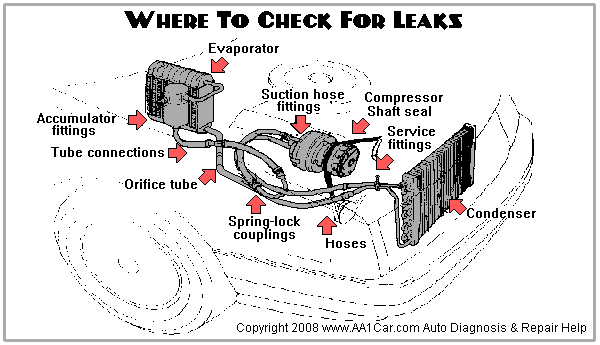 Having said that, how do you objectively go about identify the leaks. There is actually a test for this. But your FNG AC service wallah will probably not perform it, either through lack of awareness or plain laziness or cost. You may get this in the A.S.S. but then again ask for it to be performed. If you detect a leak in the plumbing - just replace. There's no return by saving pennies now for an expensive recharge of refrigerant tomorrow. Last edited by GTO : 7th May 2014 at 15:33. Reason: As requested |
| |  (6)
Thanks (6)
Thanks
|
| The following 6 BHPians Thank joybhowmik for this useful post: | Aditya, dr. sen, gm_arun, GTO, HappyWheels, parsh |
| |
| | #12 |
| Senior - BHPian Join Date: Aug 2005 Location: New Delhi
Posts: 1,467
Thanked: 2,588 Times
| My Car A/C is not working. Other problems and solutions. Courtesy AA1car.com and Courtesy:Clarks Garage Here's a quick reckoner ... 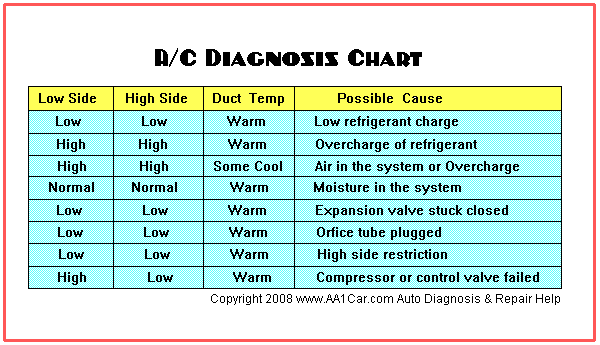 Symptoms , possible causes & Resolutions Low Compressor Discharge Pressure 1. Leak in system -> Fix the leak 2. Defective expansion valve -> Replace 3. Suction valve closed -> Open 4. Refrigerant shortage -> Recharge 5. Plugged receiver drier -> Replace 6. Compressor suction valve leaking -> Replace 7. Bad reed valves in compressor -> Replace reeds High Compressor Discharge Pressure 1. Air in system -> Recharge 2. Clogged condenser -> Clean it 3. Discharge valve closed -> Open it 4. Overcharged system -> Drain some refrigerant 5. Insufficient condenser air -> Check condenser and radiator fans. 6. Loose fan belt -> tighten (tension) 7. Condenser not centered on fan or too far from radiator -> Center and check distance Low Suction Pressure 1. Refrigerant shortage -> Recharge 2. Worn compressor piston -> Replace compressor 3. Compressor head gasket leaking -> Replace gasket 4. Kinked or flattened hose -> Replace hose 5. Compressor suction valve leaking -> Depends , if integrated suction valve - replace compressor, otherwise change valve plate. 6. Moisture in system -> Replace drier/accumulator 7. Trash in expansion valve or screen -> Replace filter & Receiver/Drier High Suction Pressure 1. Loose expansion valve -> Tighten valve 2. Overcharged system -> Drain some refrigerant 3. Expansion valve stuck open -> Replace valve 4. Compressor reed valves -> Replace reed valves 5. Leaking head gasket on compressor -> Replace gasket Compressor Not Working 1. Broken belt -> Replace belt 2. Broken clutch wire or no 12v power -> Check continuity 3. Broken compressor piston -> Replace compressor 4. Bad thermostat -> Replace thermostate 5. Bad clutch coil -> Replace clutch oil 6. Low Refrigerant - low pressure switch has cut off clutch power -> Add Refrigerant Evaporator Not Cooling 1. Frozen coil, switch set too high -> Adjust thermostat 2. Drive belt slipping -> Tension belt 3. Hot air leaks into car -> Check vents, and openings in door shut line/window frames 4. Plugged receiver drier -> Replace receiver/drier 5. Capillary tube (expansion valve) broken -> Replace valve 6. Shortage of refrigerant -> Add Refrigerant 7. High head pressure -> Check causes under High Compressor Discharge Pressure 8. Low suction pressure -> Check causes under Low Suction Pressure 9. High suction pressure -> Check causes under High Suction Pressure 10. Defective expansion valve -> Replace valve 11. Frozen expansion valve -> Evacuate system and and replace Receiver/Drier Frozen Evaporator Coil 1. Faulty thermostat -> Replace thermostat 2. Thermostat not set properly -> Adjust 3. Insufficient evaporator air -> Check for excessive duct hose length, kink or bend. Intermittent Cooling 1. Ice in the system especially in the orifice tube/expansion valve. -> Evacuate the system thoroughly(using vaccuum pump) and recharge. 2. Faulty low pressure cutout switch -> Replace 3.Faulty compressor clutch -> Check voltage to clutch terminals (if ok)-> check air gap between the drive plate and pulley (if ok/not ok) -> check resistance of clutch field coil (not ok) Replace. If no power to clutch -> check pressure switch -> if activated -> check electricals ; else; ---------------------------------------------------------------------> if deactivated -> check the pressure on high/low sides. 4.Faulty compressor clutch relay-> Check by bypassing relay altogether. If A/C works replace the relay. 5. Faulty A/C control switch. -> Replace if A/C works by bypassing the switch. 6. Problem in control module and/or temperature sensor -> Get a scan done, and note down error code and its meaning. Take appropriate action Noise 1. Caused by compressor -> Replace 2. Rattles etc. -> Check and tighten. Malodor 1. Evaporator is dirty-> Clean it. 2. Cabin air filter is dirty -> Replace it. 3. Vents and ducting is dirty -> Clean it. Also perform an A/C flush. The A/C Flush (Preventive Maintenance) Over time, the system accumulates sludge and contamination. This is from multiple sources , not the least of which is retained moisture - resulting in the formation of highly corrosive acids, that corrode the insides of hoses, and forms a sludge. This sludge is very harmful to the components of the system. It collects in the condensor, evaporator, hoses, receiver/drier. If unchecked it can choke the components with disastrous consequences. When a compressor fails due to moisture or sludge in the system, it releases metallic debris into the line. If this sludge/debris is not removed before replacement with a new compressor and other components, chances are those will fail soon too. This is why in situations like this, provided the sludge build up is not too much, it is a good idea to have the system flushed with a solvent such as Dura flush. A short video about AC flushing Last edited by joybhowmik : 3rd May 2014 at 02:49. |
| |  (14)
Thanks (14)
Thanks
|
| The following 14 BHPians Thank joybhowmik for this useful post: | Aditya, anujmishra, BlackPearl, dr. sen, gm_arun, GTO, HappyWheels, jnanesh, JoseVijay, parsh, saket77, sri2012, the1984@doctor, vikred |
| | #13 |
| Senior - BHPian Join Date: Aug 2005 Location: New Delhi
Posts: 1,467
Thanked: 2,588 Times
| So there you have it... best of luck A few top tips as we wind up. 1) Get the problem looked at asap. The more you delay , the more the chances that something else will go wrong. This is especially true for car A/Cs. There are certain categories of problems - such as progressively lower cooling , which can be ignored at your own risk. Therefore, at least get a pressure check done. That will point you in the right direction, and help save on expensive replacements in the future. 2) Make it a practice to get your AC lines flushed once every 2 years or 24k kilometers. An ounce of prevention.... 3) When going in for a recharge , it helps to first do a complete and thorough evacuation using a vaccuum pump. Assure yourself, that there's no air/moisture in the system before you recharge. An appeal to the reader: If you have something to add or feel something is not represented correctly - and you have a better explanation, do provide your views. We can all learn from our collective experience. Let's make this thread a one-stop-shop for knowledge related to automotive Air conditioners , about how they work, the kinds of problems that can occur and there solutions. I request you not to use this thread as a way to get answers to your car's AC issues. There are 'n' number of such threads in the forum, where someone or the other will be happy to help you. I request all readers to report such posts to the moderators for action due to irrelevance/inappropriateness. Last edited by joybhowmik : 3rd May 2014 at 08:40. |
| |  (14)
Thanks (14)
Thanks
|
| The following 14 BHPians Thank joybhowmik for this useful post: | Aditya, amitpunjani, BoneCollector, dr. sen, gearedup, GTO, jnanesh, JoseVijay, parsh, rishie, Sophomore, sourabhzen, sumeethaldankar, wanderernomad |
| | #14 |
| Team-BHP Support  | re: Understanding Car Air-Conditioners Thread moved from the Assembly Line to the Technical Stuff section. Thanks for sharing. |
| |  ()
Thanks ()
Thanks
|
| | #15 | |||||||
| Distinguished - BHPian  | Re: So there you have it... best of luck Nice article there, Joy, with lots of obvious homework done in connivance with Google!  Quote:
Quote:
Quote:
Quote:
Quote:
Quote:
 Quote:
| |||||||
| |  (6)
Thanks (6)
Thanks
|
| The following 6 BHPians Thank SS-Traveller for this useful post: | driverace, GTO, jeeva, parsh, phamilyman, Warwithwheels |
 |



 cycle when power from the engine causes the shaft and swash plate to rotate.
cycle when power from the engine causes the shaft and swash plate to rotate.
